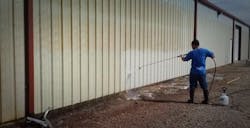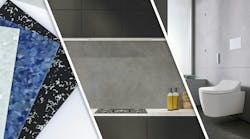Owners – and prospective owners – of metal buildings often want to know how much maintenance is necessary, and what they need to do. This is information that every metal building system builder should know. It's info that will make customers happy, because the maintenance is easy and simple.
Inspect
The most basic maintenance step is inspection. Inspect the building twice a year, looking for any damage or changes that may have occurred. Also, inspect after any renovation or new additional construction, or following an extreme weather event. As we will detail shortly, keep a sharp eye out for the small stuff, so you can fix it before it turns into big stuff.
It's a good idea to establish a regular maintenance schedule. Put inspections on the calendar at times that make sense with the local climate. For instance, a date in spring that predictably will fall after the snow clears allows the inspection to find any damage that might have been caused by winter weather. Or, an inspection date scheduled in fall before the snow usually starts will help ensure the building is ready to withstand whatever winter throws at it.
Keep maintenance records. Create an organized records system, whether it’s paper or digital. Record inspection dates and results, and the date and nature of any repairs made. If materials or equipment are purchased, add the receipts and warranty info to the file. (For a digital file, you can scan in paper documents and file the images.) Document any repairs or renovations with photos, and include contact information for all contractors, or whoever did the work. This kind of information will help unravel any questions that might later arise about what was done, or how it was done. It could be helpful for meeting government safety regulations, too, or if insurance claims need to be made, for example, after damage by a natural disaster.
Repair Damage
It is important to repair damage, even small issues, in a timely manner. Scratched steel panels should be primed and painted to prevent corrosion. Remember to make a note if there was a repair and where the repair was located so it can be double checked on the next inspection. Also, eliminate things adjacent to the building that might cause scratching again, like a nearby tree branch that sways in the wind. Any hole in the building envelope, whether the building is clad in steel panels, EIFS, brick, or wood, or any other material, should be filled and sealed. Penetrations compromise the watertightness of the building, as well as its thermal performance.
Water, whether in its familiar liquid form, its solid form as snow or ice, or in its vapor form, is the common threat to every building of every construction type. Regardless of the form, it is important to keep moisture out of the walls and the ceiling. Moisture causes corrosion, mold and bacteria growth, weakening and warping of surface materials, and deterioration of the foundation.
Inspection and repair go a long way toward securing the building against rain penetration. When it rains, take the opportunity to inspect for leaks from the interior. If any are found, trace them down and seal the exterior source. Then make sure any moisture that has gotten into walls or ceilings is allowed (even encouraged) to leave.
Prevent excessive buildup of snow on the roof or around the walls. The weight can bend metal panels. Eliminate places around the building where water can pool, to prevent both leaks into the building and damage to the foundation. Redirect as much precipitation as possible away from building. A drainage system that deals with runoff in an appropriate manner will help. A gutter system keeps roof runoff away from the walls. Permeable paving can be used adjacent to the building to eliminate puddles.
Clean the Building
Once you know the building envelope is successfully keeping moisture out, it’s a good idea to wash the building once a year. Removing any dirt, soot, or organic matter that has accumulated can preserve the appearance of your building and prevent the cladding from being stained or blemished. It will also stop the growth of fungus or other undesirable microbes. Use a mild laundry detergent, diluted with warm water. Apply by hand with a soft-bristled brush, or power-wash at low pressure. Diluted bleach can be used in instances of fungal growth. Before washing the building, always test your cleansing solution for compatibility with each of the building’s surface materials, selecting test sites that are normally concealed or inconspicuous.
These easy maintenance steps will keep a metal building system looking attractive and performing properly for many years, even decades of profitable use.
About the Author

Cary Barger
Cary Barger has been helping builders solve problems for the last 40 years by using his experience in the drafting, estimating, product development, and field service department at Star. He is also the past chairman of the construction committee at MBMA.


